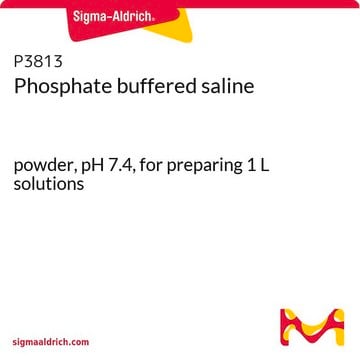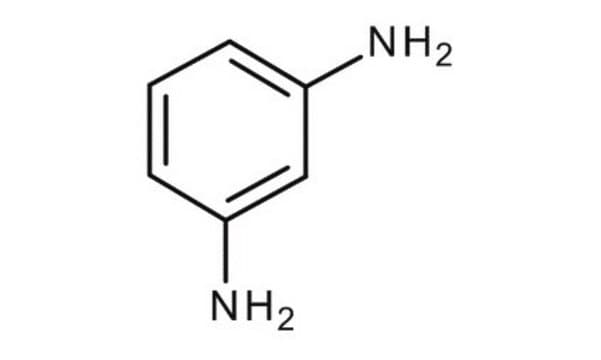We have no information on using this product for oxidase test. Product No. T3134, N,N,N′,N′-Tetramethyl-p-phenylenediamine dihydrochloride is commonly used to perform the oxidase test for the colorimetric identification of pathogenic and non-pathogenic bacteria.
P6001
p-Phenylenediamine
98% (GC)
Synonym(s):
1,4-Benzenediamine, 1,4-Diaminobenzene, 1,4-Phenylenediamine
Select a Size
Select a Size
About This Item
Recommended Products
vapor density
3.7 (vs air)
Quality Level
vapor pressure
1.08 mmHg ( 100 °C)
description
anti-fade reagent
Assay
98% (GC)
bp
267 °C (lit.)
mp
138-143 °C (lit.)
SMILES string
Nc1ccc(N)cc1
InChI
1S/C6H8N2/c7-5-1-2-6(8)4-3-5/h1-4H,7-8H2
InChI key
CBCKQZAAMUWICA-UHFFFAOYSA-N
Looking for similar products? Visit Product Comparison Guide
Application
- to evaluate its sensitization potential in vitro in langerhans-like dendritic cells and autologous T cells[1]
- to treat the dorsal sides of the ears of mice, to study its systemic immunological effects[2]
- in glycerol to coverslip coronal sections in the attempt to count Aβ plaques[3]
Anti-fade reagent is added to the mounting medium in fluorescence microscopy to retard photobleaching of fluorescein and other fluorescent dyes.
Biochem/physiol Actions
Caution
Signal Word
Danger
Hazard Statements
Precautionary Statements
Hazard Classifications
Acute Tox. 3 Dermal - Acute Tox. 3 Inhalation - Acute Tox. 3 Oral - Aquatic Acute 1 - Aquatic Chronic 1 - Eye Irrit. 2 - Skin Sens. 1 - STOT SE 1 Oral
Target Organs
Kidney,Heart,Musculo-skeletal system
Storage Class Code
6.1C - Combustible acute toxic Cat.3 / toxic compounds or compounds which causing chronic effects
WGK
WGK 3
Flash Point(F)
230.0 °F - closed cup
Flash Point(C)
110 °C - closed cup
Personal Protective Equipment
Choose from one of the most recent versions:
Already Own This Product?
Find documentation for the products that you have recently purchased in the Document Library.
Customers Also Viewed
-
May I ask if I can use P- phenylenediamine for oxidase test
1 answer-
Helpful?
-
-
What is the solubility of p-Phenylediamine, Product P6001?
1 answer-
This product is soluble in ethanol at a concentration of 50 mg/mL, with heating. A clear red to brown solution is observed.
Helpful?
-
-
What is the Department of Transportation shipping information for this product?
1 answer-
Transportation information can be found in Section 14 of the product's (M)SDS.To access the shipping information for this material, use the link on the product detail page for the product.
Helpful?
-
-
For what applications is p-Phenylediamine, Product P6001, used?
1 answer-
This is an antifade reagent that is used as a fluorescent stabilizer. Do not confuse the p-phenylenediamine with o-phenylenediamine, which is used as a peroxidase substrate in ELISA procedures.
Helpful?
-
-
What is the working concentration for p-Phenylediamine, Product P6001, when used as an antifade agent?
1 answer-
J. Immunological Methods, 43, 349 (1981) describes a solution that will reduce the fading of fluorescent materials. The recipe for this solution is: "Add 10 mL of phosphate-buffered saline (0.01 M PO4, pH 7.4 in 0.15 M NaCl) containing 100 mg of p-phenylenediamine to 90 ml of glycerol. The final pH should be adjusted to approximately 8.0 with 0.5 M carbonate-bicarbonate buffer (pH 9.0)".
Helpful?
-
Active Filters
Our team of scientists has experience in all areas of research including Life Science, Material Science, Chemical Synthesis, Chromatography, Analytical and many others.
Contact Technical Service









